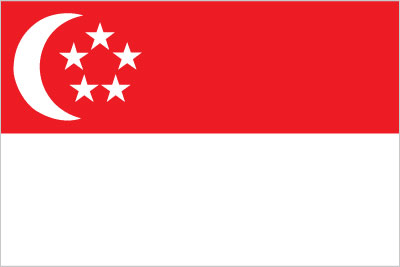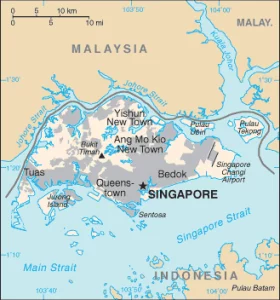Exporting to Singapore


Singapore Country Profile
Official Name (Local Language) Republic of Singapore
Capital Singapore
Population 5,781,728
Currency Singapore Dollar
GDP $296.6 billion
Languages Chinese; English
Telephone Dial In 65
Singapore Imports Profile
Exports ($m USD) 327,710
Number of Imports Products 4,309
Number of Imports Partners 222

Singapore Economic Statistics
Government Website | https://www.gov.sg/ |
| Sovereign Ratings | https://countryeconomy.com/ratings/singapore |
| Central Bank | Monetary Authority of Singapore |
| Currency USD Exchange Rate | 1.379 |
| Unemployment Rate | 2.1% |
| Population below poverty line | NA |
| Inflation Rate | -0.8% |
| Prime Lending Rate | 1.17 |
| GDP | $296.6 billion |
| GDP Pro Capita (PPP) | $87,100 |
| Currency Name | Singapore Dollar |
| Currency Code | SGD |
| World Bank Classification | High Income |
| Competitive Industrial Performance | 2/138 |
| Corruption Perceptions Index | 6/180 |
| Ease of Doing Business | 2/190 |
| Enabling Trade Index | 1/136 |
Access trade, receivables and supply chain finance
We assist companies to access trade and receivables finance through our relationships with 270+ banks, funds and alternative finance houses.
Get StartedExporting to Singapore
Singapore is one of the most significant hubs for global trade, housing the world’s second-busiest container port and an economy that is highly reliant on both imports and exports. Singapore’s main imports are integrated circuits, refined oil, ships, and precious metals. Its main import sources are China, Malaysia, Western Europe, and the US. Singapore’s growing domestic market, highly skilled workforce, and varied industry environment make it an extremely attractive destination for exports, especially of consumer goods, transportation, and high-tech services.
Singapore maintains a trade surplus by promoting exports, but also encourages imports through one of the most liberal trade regimes in the world. A very small sector of products such as motor vehicles, alcohol, tobacco, and chewing gum are subject to high tariffs for environmental reasons, but 99% of its exports are not subject to any import duty at all and only to very low Goods And Services tax. The logistics of imports are also extremely easy, as Singapore’s port and airport infrastructure is among the most advanced and efficient in the world. Singapore is a member of the largest trade deal in the world, the Regional Comprehensive Economic Partnership, guaranteeing free trade with most South-East Asian nations as well as Australia, New Zealand, South Korea, India, Japan and China.
The Singaporean domestic economy is extremely open to exports, but has experienced challenges due to the war in Ukraine and rising inflation that may depress demand. Ambitious infrastructure projects financed by the government, including a new port and an expansion of its airport, could boost the economy and be crucial export opportunities.
Exporting to Singapore: What is trade finance?
Singapore’s exports peaked at $9,196 million recently due to the country’s existing infrastructure and skilled workforce that allowed it to purchase raw goods and manufacture them for re-export such as in the industries of water fabrication and oil refining. Citing the Harmonized System (HS) classification the top exports of Singapore are namely: refined petroleum (at least $60 billion), integrated circuits ($40 billion) and oxygen amino compounds (around $6 billion). Meanwhile, Hong Kong ($30 billion), China ($30 billion) and Indonesia ($30 billion) were considered top export destinations of Singaporean products.
Chart Showing GDP Growth Compared to rest of world
GDP Composition for Singapore
Agriculture
0%
Orchids, vegetables; poultry, eggs; fish, ornamental fish
Industry
26.6%
Electronics, chemicals, financial services, oil drilling equipment, petroleum refining, rubber processing and rubber products, processed food and beverages, ship repair, offshore platform construction, life sciences, entrepot trade
Services
73.4%
Map
Top 5 Import Partners
| Country | Trade | % Partner Share |
| China | 45,344 | 13.84 |
| Malaysia | 38,86 | 11.86 |
| United States | 34,619 | 10.56 |
| Other Asia, nes | 27,139 | 8.28 |
| Japan | 20,485 | 6.25 |
Top 5 Import Products
| Export Product | Number |
| Monolithic integrated circuits, nes | 18.1% |
| Petroleum oils, etc, (excl. crude); preparation | 14.3% |
| Petroleum oils and oils obtained from bituminou | 6.5% |
| Gold in other semi-manufactured forms, non-monetary | 4.0% |
| Parts of turbo-jets or turbo-propellers | 2.7% |
Local Authors
Local Partners
- All Topics
- Singapore Trade Resources
- Export Finance & ECA Topics
- Local Conferences

























